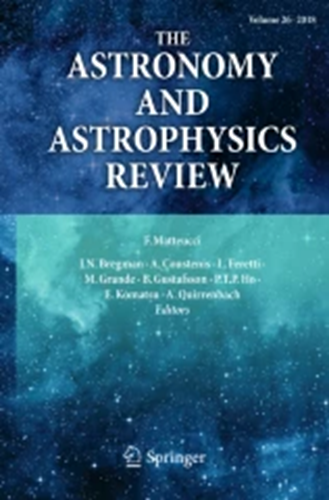Local alignments of parsec-scale AGN radiojets
IF 27.8
1区 物理与天体物理
Q1 ASTRONOMY & ASTROPHYSICS
引用次数: 0
Abstract
Context.Coherence in the characteristics of neighboring sources in 2D and 3D space may suggest the existence of large-scale cosmic structures, which are useful for cosmological studies. Numerous works have been conducted to detect such features in global scalesas well as in confined areas of the sky. However, results are often contradictory and their interpretation remains controversial. Aims.We investigate the potential alignment of parsec-scale radio jets in localized regions of the coordinates-redshift space. Methods.We use data from the Astrogeo VLBI FITS image database to deduce jet directions of radio sources. We perform the search for statistical alignments between nearby sources and explore the impact of instrumental biases. Results.We unveil four regions for which the alignment between jet directions deviates from randomness at a significance level of more than 5 sigma and is unlikely due to instrumental systematics. Intriguingly, their locations coincide with other known large-scale cosmic structures and/or regions of alignments. Conclusions.If the alignments found are the result of physical processes, the discovered regions may designate some of the largest structures known to date.秒差距尺度AGN射电喷流的局部对准
上下文。二维和三维空间中相邻光源特征的相干性可能表明大尺度宇宙结构的存在,这对宇宙学研究是有用的。已经进行了大量的工作,以在全球范围内以及在天空的有限区域内检测这些特征。然而,结果往往是相互矛盾的,其解释仍然存在争议。目标我们研究了秒差距尺度射电喷流在坐标红移空间局部区域的潜在对准。方法。我们使用来自Astrogeo VLBI FITS图像数据库的数据来推断射电源的喷射方向。我们在附近的来源之间进行统计一致性的搜索,并探索工具偏差的影响。结果。我们揭示了四个区域,其中射流方向之间的对齐偏离随机性的显著性水平超过5西格玛,并且不太可能由于仪器系统。有趣的是,它们的位置与其他已知的大规模宇宙结构和/或排列区域相吻合。结论。如果发现的排列是物理过程的结果,那么发现的区域可能会指定迄今为止已知的一些最大的结构。
本文章由计算机程序翻译,如有差异,请以英文原文为准。
求助全文
约1分钟内获得全文
求助全文
来源期刊

The Astronomy and Astrophysics Review
地学天文-天文与天体物理
CiteScore
45.00
自引率
0.80%
发文量
7
期刊介绍:
The Astronomy and Astrophysics Review is a journal that covers all areas of astronomy and astrophysics. It includes subjects related to other fields such as laboratory or particle physics, cosmic ray physics, studies in the solar system, astrobiology, instrumentation, and computational and statistical methods with specific astronomical applications. The frequency of review articles depends on the level of activity in different areas. The journal focuses on publishing review articles that are scientifically rigorous and easily comprehensible. These articles serve as a valuable resource for scientists, students, researchers, and lecturers who want to explore new or unfamiliar fields. The journal is abstracted and indexed in various databases including the Astrophysics Data System (ADS), BFI List, CNKI, CNPIEC, Current Contents/Physical, Chemical and Earth Sciences, Dimensions, EBSCO Academic Search, EI Compendex, Japanese Science and Technology, and more.
 求助内容:
求助内容: 应助结果提醒方式:
应助结果提醒方式:


